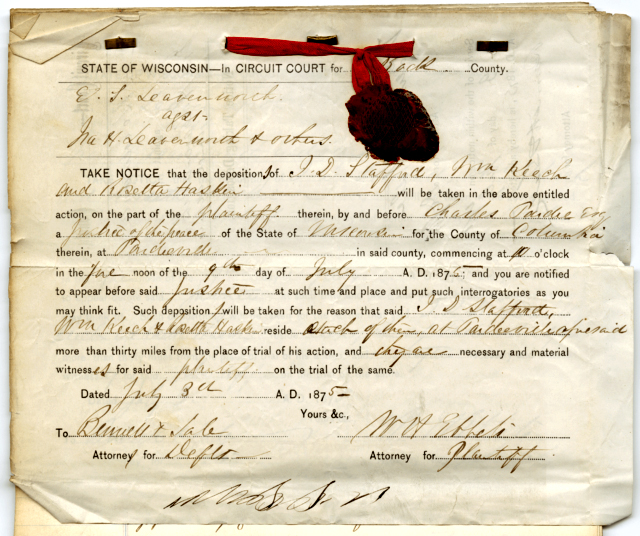A Close Up of Lavinia’s Law Practice
Today’s post plus two new tabs on the navigation menu provide a rare glimpse of what it was like to be Wisconsin’s first woman lawyer. The “Court Cases” page features 5 of Lavinia Goodell’s clients and cases along with recently unearthed pleadings from her court files. The “Supreme Court Battle” page chronicles the dramatic series of events from her first failed motion for admission to the Wisconsin Supreme Court, to her legislation prohibiting sex discrimination in the practice of law, to her deathbed victory in Ingalls v. State, proving that women could argue in the Wisconsin Supreme Court and win there too. But first, a little about Lavinia’s law practice.

For most of her legal career, Lavinia was a sole practitioner. She drafted deeds and wills, filed collection actions, and litigated contract, divorce and criminal cases. In November 1877, she wrote about her practice in “A Day in the Life of a Woman Lawyer,” a description that may sound comically familiar to lawyers today. For example, she began her illustrative workday short on sleep due to tossing and turning over a case that she expected to lose because her opposing counsel was the judge’s friend and valuable political ally.
She headed to the office intending to work on a brief but got distracted by a big stack of mail. It included a letter from an irate, wealthy client complaining about her $5.00 invoice for advice that saved him $500. She also received a letter from a convict wanting her to obtain a pardon for him and advance him the necessary costs for it too. He promised to repay her after he was freed and got a job.
She learned that a deposition for one of her cases had been filed in court. She dashed to the courthouse to read it and afterward stopped at the jail to see a client accused of arson. She headed back to the office to discover people waiting to see her. One needed a deed drafted. Another needed a partnership contract. A young woman carrying a baby said she had been deserted by her husband and wanted a divorce.
After these folks left, Lavinia began working on her brief, only to be interrupted by a visit from an elderly woman who suffered from “diffuseness” and a “clinging fondness for irrelevant details.” She had been defrauded and sued. Lavinia took pity and drafted an answer for her. Then she headed to the court commissioner’s office to conduct the supplementary examination of a man who owed his servant girl wages but refused to pay them.
Back at her office she received another letter from a client refusing to pay her bill—this time for a case she had won. More people stopped by to chat. By the end of the day she had made no progress on her brief, so she took it home and vowed to work on it that night. Sound familiar?!
Please visit the new “Court Cases” and “Supreme Court Battle” pages to explore the law practice of Wisconsin’s first woman lawyer. CB
Sources consulted: “A Day in the Life of a Woman Lawyer,” Woman’s Journal at 374, 11/10/1877 at 354.







